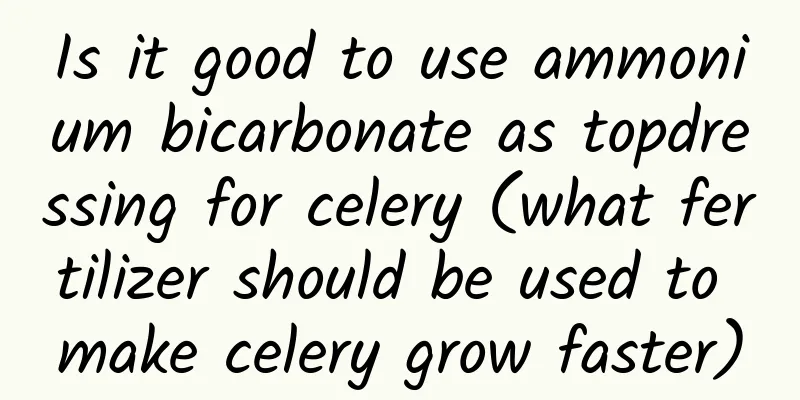Is it good to use ammonium bicarbonate as topdressing for celery (what fertilizer should be used to make celery grow faster)

First, learn about ammonium carbonateAmmonium bicarbonate is the abbreviation of ammonium bicarbonate, a fast-acting nitrogen fertilizer, white or light white crystals, easily soluble in water, with a strong pungent ammonia smell, alkaline, strong hygroscopicity, easy to clump, easy to decompose and volatilize, and heavy losses . Ammonium bicarbonate is generally used as base fertilizer and topdressing fertilizer. It is not suitable as seed fertilizer, especially it should not come into direct contact with seeds, otherwise it will easily burn the seeds. Ammonium bicarbonate should not be used for foliar spraying, otherwise it will burn the leaves. When applying ammonium sodium bicarbonate, you must grasp the basic principles of "one, do not leave the soil, two, do not leave the water", and adhere to the "six no applications", that is, do not apply it without mixing with fine soil, do not apply when there is dew, do not apply on rainy days, do not apply when there is no water in the field, do not apply in the sun, and do not spray on leaves. 2. How to use nitrogen fertilizer for celeryCelery has a high yield and requires a large amount of fertilizer. Sufficient nitrogen fertilizer is needed to make the petioles plump and tender, so a large amount of nitrogen fertilizer is applied during the entire growth period of celery. However, celery has a shallow root system. On the basis of sufficient base fertilizer, topdressing should follow the principle of "light fertilizer, frequent application, and continuous supply of quick-acting nitrogen fertilizer". Our area is known as the hometown of vegetables, and we grow a lot of celery because of its high yield. It is cultivated in both open fields and greenhouses. We use nitrogen fertilizer for celery here, mainly ammonium bicarbonate, not urea. Why? Based on years of experience in growing celery, applying urea to celery will increase the fiber content of the celery and make it thicker, causing the plant to age and grow slowly. It will also taste bitter and have poor quality. However, applying ammonium bicarbonate and organic fertilizer will make the celery tender, crisp, sweet, and help improve its quality. 3. Which nitrogen fertilizer is more suitable as foliar fertilizer?There are many types of nitrogen fertilizers, mainly ammonium nitrogen fertilizers, such as ammonium sulfate, ammonium chloride, ammonium bicarbonate, ammonia water, etc. Nitrate nitrogen fertilizers, such as calcium nitrate and sodium nitrate; ammoniacal nitrate nitrogen fertilizers, such as ammonium nitrate and calcium ammonium nitrate; Amide nitrogen fertilizers, such as urea, lime nitrogen, etc. Among all the nitrogen fertilizers, if used as foliar fertilizer, urea is better than nitrate nitrogen fertilizer, and nitrate nitrogen fertilizer is better than ammonium nitrogen fertilizer in terms of its effect. In short, we will not use ammonium carbon as foliar fertilizer, especially for green leafy vegetables, because the leaves are tender and can easily be burned. Moreover, it is not suitable to apply ammonium nitrate to leafy vegetables, and it is also forbidden to apply ammonium sulfate repeatedly. Ammonium bicarbonate cannot be applied when the vegetable field is short of water. It is forbidden to spray high-concentration nitrogen fertilizers, and greenhouse vegetables should avoid the use of high-concentration ammonium nitrogen fertilizers. |
Recommend
The planting prospects and high-yield cultivation techniques of Ginger
Yanghe ginger, also known as yahe, louhe, and wil...
How and when to plant ice grass
Before cultivating ice grass, you must first sele...
Bougainvillea pictures
Bougainvillea Tips The morphological characterist...
How many times does Kalanchoe bloom in a year?
1. How many times does it bloom? Under normal cir...
Rubber tree growth environment conditions and characteristics
Rubber tree growth environment conditions and req...
What to do if the leaves of Pyracantha turn yellow
1. Reason 1. Environmental issues It prefers slig...
Planting method of peony root tuber with buds
1. Level the land Before planting, the land must ...
The difference between rose and rose
1. The number of flowers on the branches is diffe...
How to water the Internet celebrity tree
Tips for watering popular trees The internet cele...
Cockscomb cultivation methods and precautions
Cockscomb cultivation method soil Cockscomb is no...
When I get old, I want to build a vegetable garden with you, grow vegetables with my head lowered, and enjoy the flowers when I look up!
Our vegetable garden doesn't need to be far a...
Four seasons maintenance method of stone lotus
one. spring 1In spring, it is best placed on a ba...
Cultivation methods and precautions of fragrant lily
soil Lilies prefer deep and fertile soil. Remembe...
Tipping methods for different varieties of petunias
Importance of pinching Different people raising t...
Dig some of it from the stinky ditch and plant it in a pot. It actually beats the potted plants you buy at a high price at the flower market!
Water hyacinth Every time this season comes, expe...









